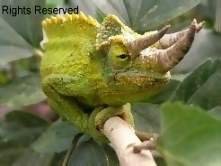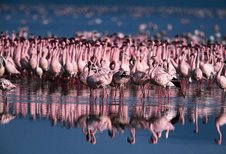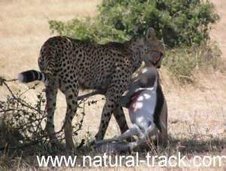The wilds of Africa are often associated with snakes
and rightly so, but, unfortunately, usually for the wrong reasons. Africa is
well known amongst herpetologists and snake lovers for the interesting variety
of species of which some are unfortunately highly priced in the pet trade.
Although many of the African snakes’ species are
completely harmless to humans, this region also hold some of the worlds most
deadly snakes. The Black and Green Mamba, Puff Adder, Cobra, Boomsland, and
Saw-scaled Vipers are some of the worlds most deadly snakes and deserve a great
deal of respect.
In east Africa, there are close to 200 species of
snakes. Of these 200, 47 are considered dangerous to humans, 45 are venomous
and two are large constrictors (two species of pythons very similar in
appearance). Of the 47 dangerous species
mentioned, 18 species are known to have killed people.
Kenya is home to several of the most dangerous
species for example, the Puff Adder (Bitis
arietans), Black-necked Spitting cobra (Naja
nigricollis) and Black Mamba (Dendroaspis
polylepis). However, Kenya is also home to many harmless species that feed
on rats and mice that consume maize, millet and rice, the stable diet of the
people of Kenya.
The simplest way of describing snakes is whether a
snake is Harmless, Mildly Venomous or Dangerous. Some snakes have no venom and
are completely harmless like the Brown House Snake. Others like large pythons
may be non-venomous but are still considered dangerous.
Sand snakes (genus
Psammphis) are considered mildly venomous. This means that the venom is strong
enough to subdue or kill its prey, like a small lizard, but not strong enough
to kill an adult human. However, one should still be careful around these fast
moving serpents. Young children or adults that have allergic reactions could
suffer severe symptoms from the bite of a sand snake!
In general, African is home to an abundance of
different snake species. From its deserts to savannahs, the African landscape
is home to an enormous variety of extremely beautiful and potentially dangerous
snakes. Below are some of the most popular snake classification;
Colubridae / Colubrids – A Colubrid is a snake that is a member of the
Colubridae family. It is a broad classification of snakes that includes well
over half of all snake species on earth. While most colubrids are non-venomous
(or have venom that isn't known to be harmful to humans) and are normally
harmless, a few groups, such as genus Boiga, Coluber and Rhabdophis, can
produce medically significant bites. In addition, the Boomslang and African
Twig Snake have both caused human fatalities.The venom-injecting fangs
associated with venomous colubrids are almost always in the back of the mouth,
compared to vipers and elapids. In North America, all snake species in the colubridae
family are generally harmless to humans. Please note: This list does not
currently include sub-species.
Elapidae/ Elapids (Venomous)
– The cobra family is thought to have evolved from Colubrid snakes and many
appear very similar in appearance with long, slender bodies and large scales
(plates) on the head. They differ in having more advanced venom delivery
systems than the venomous Colubrids. Elapids have fangs that are
"effectively tubular" in that the fangs contain grooves that are
enclosed by an infolding of the edges. The fangs are in the front of the mouth
rather than the rear as is seen in venomous Colubrids. The Elapidae contains
some of the world's most dangerous snakes including cobras (Naja), mambas
(Dendroaspis) and sea snakes (Hydophinae and Laticaudinae). Elapids are found
worldwide and in Ausralia is the predominant family. In North America, three
species of elapids are found, two species of coral snakes and one sea snake.
The coral snakes are relatively small snakes that spend most of their time
underground. Their primary food is other snakes. Despite their small size and
small fangs, their venom is extremely toxic.
Viperidae
/ Vipers (Venomous) – The vipers
are generally considered to be the most advanced family of snakes since they
possess a very sophisticated venom delivery system. Large tubular fangs are
placed in the front of the mouth and they are hinged, allowing them to be
folded back when not in use. Their heads are covered with numerous small scales
and their eyes have vertically eliptical pupils.
What to do when you meet a snake?
First of all, except for the slow-snakes like puff
adders, you will generally see a snake swiftly pass by you, not even enough
time to take a photo. That being a general rule, always leave snakes alone,
don’t touch them unless you are a professional snake handler. Like all
wildlife, they deserve their respect and distance from our interference. Except
for cases where human-pet life is in danger, leave them alone, unless it is
absolutely necessary to have them moved.
Have a wonderful day and enjoy these earths’
beautiful creatures.
PKP. Kenya safari
Natural Track Safaris.
Natural Track Safaris.









No comments:
Post a Comment